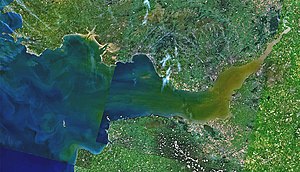Bristol Channel
| Bristol Channel Bristol Channel, Môr Hafren |
||
|---|---|---|
|
Map of the Bristol Channel |
||
| Waters | Celtic sea | |
| Land mass | Great Britain (island) | |
| Geographical location | 51 ° 22 ′ N , 3 ° 50 ′ W | |
|
|
||
| width | 87.41 km | |
| depth | 179.8 km | |
| Greatest water depth | 73 m | |
| Islands | Flat Holm , Steep Holm , Sully Island , Tusker Rock , Caldey Island , St Catherine's Island , Denny Island | |
| Tributaries | Severn , River Usk , River Taff , River Afan , River Neath , River Tawe , River Loughor , Gwendraeth , River Towy , River Avon , River Parrett , Lynmouth Rivers , River Heddon , River Taw | |
|
Satellite image |
||
The Bristol Channel ( English Bristol Channel ; Welsh Môr Hafren ) is a bay on the west coast of Great Britain , between England ( Somerset , Devon ) and Wales .
The term canal stands for " strait ", it is a funnel-shaped sea bay of the Atlantic , which forms the mouth of the River Severn in the inner part .
The IHO delimits the Bristol Channel to the west to the Celtic Sea by the line Cape St. Govan's Head in the north and Hartland Point in the south. The distance between the two points is 67 kilometers. The Hydrographer of the Navy makes a rough demarcation with a line from St. Govan's Head over the island of Lundy to Hartland Point. According to these delimitations, Lundy lies outside (around 1.4 km to the west) or exactly on the sea border of the Bristol Channel.
The location, orientation and geometry of the water body in the bay create the highest tidal range in England . On the Welsh side, the most important ports on the Bristol Channel are Cardiff and Swansea , the eponymous Bristol is connected to the Bristol Channel via the River Avon .
On January 20th jul. / January 30th 1607 greg. the Bristol Channel was affected by a serious natural disaster when a tidal wave flooded the coast and around 2000 people were killed.
Tidal power plants
Severn Barrage
The construction of the world's largest tidal power station under the name Severn Barrage was planned for a long time in the Bristol Channel . At the mouth of the Severn between Cardiff and Bristol , a 16-kilometer barrier was to be built through the Bristol Channel. The 216 turbines planned there should achieve a total output of 8,500 MW and thus cover five percent of UK electricity consumption. The location is favorable for a tidal power plant due to the high tidal range of up to 15 meters. The project has been estimated to cost £ 15 billion (€ 19 billion). This major project was the subject of controversy in Great Britain. Various environmental groups turned against the construction of the Severn Barrage because of the expected environmental damage. The follow-up to the project was stopped by the UK government at the end of 2010 after a feasibility study calculated costs of up to £ 34 billion.
Swansea Bay
As a successor to the abandoned Severn Barrage project , planning began in 2010 for the Swansea Bay tidal power plant, which is much smaller with 320 MW, in Swansea Bay, a bay near the city of Swansea on the north coast of the Bristol Channel.
The construction was approved by the Ministry of Energy in 2015, and construction was scheduled to start in June 2020 [obsolete] . The construction time was set at around four years (with the first electricity generation in the third year). In 2018, the Department for Business, Energy and Industrial Strategy (BEIS) announced that the project would not be pursued any further.
Individual evidence
- ^ International Hydrographic Organization: Limits of Oceans and Seas, 3rd edition + corrections, 1971 , p. 42
- ^ Severn Barrage tidal power plant project
- ↑ Britain Plans World's Biggest Tidal Power Station. In: Spiegel Online. August 7, 2008, accessed December 5, 2014 .
- ↑ PDF of the British National Archives
- ↑ Tidal Power Plants in Great Britain at Spiegel-Online, accessed March 4, 2015
- ↑ Swansea Bay tidal lagoon wants to start work. In: WalesOnline. May 14, 2020, accessed June 7, 2020 .
- ^ An iconic, world-first infrastructure project in South West Wales. tidallagoonpower.com. Retrieved December 2, 2017.


